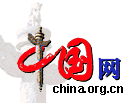With just a press of a lever you can flush your toilet.
Think of one person flushing several times a day and using 100 liters of fresh water coupled with continuously expanding drought areas around the country and across the world, and the pressure on natural resources is obvious.
To help save water, the Standardization Administration of China launched a compulsory standard for toilet makers earlier this year requiring them to produce 6-litre flush toilets instead of the 9-12 liters ones now on the market.
Since water-saving toilets require higher technology, most of the flush toilets on the market need more than 6 liters of water, said Ruan Fucheng with the China Construction and Decoration Association.
"Some toilet producers make dozens of type of toilets but with only one or two water-saving ones," Ruan said. However, "to promote their products, some producers claim all their products are only using 6 liters of water per flush and some use just 3 to 4 liters."
As the price of water keeps going up and the improving awareness of environmental protection grows, water-saving toilets are gaining popularity among Chinese consumers.
"Many consumers pay attention to the water volume of their toilets, as well as the color, shape and brand," said Xu Long, a booth owner in the Easy Home Construction Material Market in Beijing.
The types of water-saving toilets vary from a two-button toilet which has a 6-litre button and a 3-litre button to a pressure control toilet which releases differing water amounts. Some toilets can even collect daily waste water to flush the toilet, Xu said.
Thanks to Sir John Harington, a Britain who is credited with inventing the flush toilet in 1596, most of Chinese urban dwellers can have comfortable experience in a relatively clean restroom.
It is a common practice for Chinese to use freshwater to flush their toilets, which accounts for 30 to 35 percent of the total volume of water used in offices and for domestic purposes.
However, China's per capita freshwater resources are one quarter of the world's average. Nearly 400 of China's 600-plus cities are short of water, particularly in the more densely populated coastal areas.
Residents of Qingdao in east China's Shandong Province will be the first in the country to flush their toilets with seawater as part of a pilot project currently underway.
Residents in the city's Nanjiang Development Zone will only pay 0.5 yuan (6 US cents) per ton of processed seawater, or about one-eighth the average price of tap water in most major Chinese cities.
Qingdao consumes about 60,000 cubic meters of water a day for toilet flushing while the city keeps struggling with a shortage of freshwater.
The project has become feasible since technological breakthroughs have been made in seawater purification, disinfection and biochemical treatment, and specified standards for water quality and drainage, according to local officials.
In some rural areas such as in south China's Guangxi Zhuang Autonomous Region, water-free clean toilets which use disposable plastic bags to hold human wastes which can later be returned to farm as organic fertilizer have been promoted.
Minister of Water Resources Wang Shucheng said he is confident that China has great potential to use water efficiently and he has urged authorities to push water conservation efforts.
"Building a water-saving society will be the only fundamental outlet for China to tackle the issue today and maintain sustainable development in the future," Wang said.
The central government is expected to draft a water-saving program based on pilot projects already carried out.
For example, the city of Zhangye, in northwest China's Gansu Province, has put forth water-use quotas for daily and industrial purposes.
(China Daily March 23, 2004)

